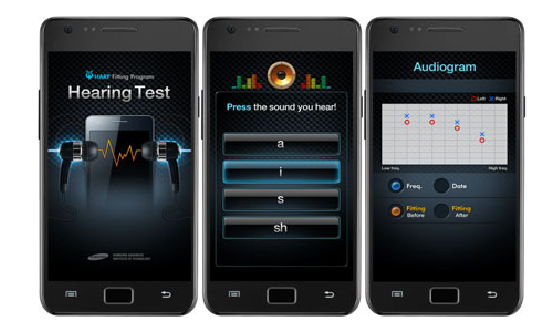Phoneme-Based Self Hearing Assessment on a Smartphone
By Jong Min Choi, Junil Sohn, Yunseo Ku, Dongwook Kim, and Junghak Lee
NOTE: This is an overview of the entire article, which appeared in the May 2013 issue of the IEEE Journal of Biomedical and Health Informatics.
Click here to read the entire article.
Ground-breaking research in e-health applications for smartphones may soon make it easier, more convenient, and less costly for individuals to conduct auditory self-assessments. The possibility of implementing hearing tests on a smartphone is now widely accepted, but this particular article introduces a promising new method of audiometry using phonemes instead of pure tones.
The authors propose using the four Korean phonemes most similar to the English phonemes /a/, /i/, /sh/, and /s/. Tests were conducted on 15 subjects diagnosed with mild to severe hearing loss, and the phoneme-based hearing assessment was found to be sufficiently reliable in estimating the hearing thresholds of hearing impaired subjects. In a previous paper, these researchers proposed the phoneme-based assessment (PhoSHA) and have now implemented it on a smartphone running the Android operating system.

PhoSHA application on the Samsung smartphone.
In this study, the authors noted that new research of e-health applications using a Smartphone as an e-health gateway or mobile healthcare device has shown that operating platforms such as Apple iOS and Google Android provide an excellent environment for e-health application. Smartphones are becoming increasingly powerful, using modern audio codec chips that provide high quality audio making it possible to conduct hearing tests, like pure-tone audiometry, on the smartphone. The idea behind using phonemes rather than pure-tones is that because it uses words rather than pure tones, it should help the hearing-impaired with speech intelligibility, something many clinicians say is the most important aspect for patients.
In evaluating the study, several things had to be considered, including the ages of the subjects and the properties of the earphones used. Understandably, subjects under 50 years of age understood the procedures using a smartphone and were able to perform the tests themselves. Conversely, most subjects over the age of 50 had difficulty performing the smartphone assessment. The main factor here was that there was a difference in age between normal hearing and hearing-impaired subjects; normal hearing subjects were generally younger than the hearing-impaired subjects. The conclusion was that there is a statistically significant difference in test time between the normal hearing group and the hearing-impaired group.
Since different earphones can give very different results due to their acoustic properties, it was also necessary to factor in these discrepancies in the overall evaluations of the hearing tests. Although the performance of smartphone audio codec chips is rapidly improving, background noise was also a problem.
The authors concluded that the use of phonemes can be used to complete audio self-assessments on smartphones with sufficient accuracy and reduced test time. Just as with the results of conventional audiograms, the results of this method can be used to fit hearing aids.
ABOUT THE AUTHORS
Authors’ photographs and biographies were not available at the time of publication of the original article.






